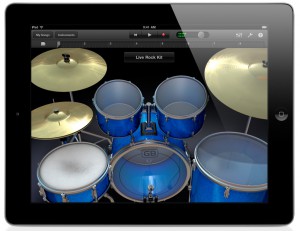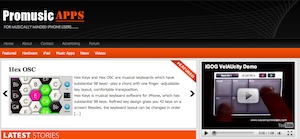 It’s very unlikely you’re unaware of the iPad, and chances are you’re also aware the iPad 2 was announced today. For most people it’s likely an incremental upgrade for the popular tablet. The thinner, faster iPad with an optional white colour scheme sure looks nice and it’ll no doubt be more fun to use with the dual-core chip. For most people however, it doesn’t go much beyond that. One exception that stands out for me in a big way are musicians. I don’t just mean electronic musician geeks like me. I mean guitarists, drummers, bass players and pretty much anything else you can think of. Why?- because GarageBand is now a serious option on the iPad. There’s been no shortage of music recording apps for the iPad, but having the well known music-sketchpad on there is a big plus. The faster processor is another important part of the equation from a music creation viewpoint.
It’s very unlikely you’re unaware of the iPad, and chances are you’re also aware the iPad 2 was announced today. For most people it’s likely an incremental upgrade for the popular tablet. The thinner, faster iPad with an optional white colour scheme sure looks nice and it’ll no doubt be more fun to use with the dual-core chip. For most people however, it doesn’t go much beyond that. One exception that stands out for me in a big way are musicians. I don’t just mean electronic musician geeks like me. I mean guitarists, drummers, bass players and pretty much anything else you can think of. Why?- because GarageBand is now a serious option on the iPad. There’s been no shortage of music recording apps for the iPad, but having the well known music-sketchpad on there is a big plus. The faster processor is another important part of the equation from a music creation viewpoint.
Aside from GarageBand, the reason I’m convinced the latest iPad iteration is going to make a splash is the level of adoption of the platform by other hardware manufacturers. Using my own passion of synths and keyboards as an example, there are already a bunch of options around for using an iPad as the display / sound source / editing interface for a range of keyboard gear. It makes a hell of a lot of sense – with the growing adoption of tablets, why would you create your own proprietary LED / LCD screen in a synth? Install an iPad dock and allow people to take it from there. The more innovative manufacturers are already looking at ways to allow importation of sounds for a synth from the iPad and there are already controller keyboards (that don’t contain any sounds themselves) that allow the use of the iPad as the sound source rather than a PC or Mac.
My only concern on this falls around the docking connector itself. Apple are renowned for changing connectors and if I’ve spent thousands on a workstation synth that relies on an iPad as its interface, then I may have a large problem a couple of years down the track. Sure there may be adapter options but workarounds like that can be frustrating at best. It’s a risk with most technology so it’s hard to complain too hard on that front.
For the guitarist / bass player / drummer, the prevalence of amp modelling software and soft synths / drum machines, combined with either GarageBand or third-party sound recording apps, is providing a real option for both home and performing musicians. Although the iPad’s sound input options are pretty limited, there are plenty of audio interfaces around designed to help out and things are only going to get better in that regard.
Is the iPad the Messiah? Not at all. Are there alternatives? Absolutely and you should check them out. Does it have limitations? Damn straight it does – the size of its flash memory, lack of USB and the incredibly restrictive file sharing options outside of iTunes are three big ones. All that said, as an evolutionary development musicians should be sitting up an taking a lot of notice. The novelty value of bands like Atomic Tom has pretty much expired. In its place is a growing acceptance of the tablet computer as an intrinsic part of the modern musician armoury. I play in an 80s/90s cover band and I’m already planning on integrating an iPad into my rig – I somehow think I’m not alone in that.



Recent Comments